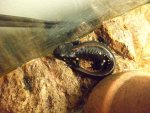firedreams
2010 Research Grant Donor
- Joined
- May 31, 2009
- Messages
- 243
- Reaction score
- 7
- Points
- 0
- Location
- Toronto, ON
- Country
- Canada
- Display Name
- Lydia
We have had our P. chinensis juvies for about 9 months. They all started at the same size, but one ('Roger') has not grown as much as the others, and refuses to enter the water. He is not an aggressive eater and often takes a dozen attempts to get an earthworm slice into his mouth. He lives on a small island in an otherwise aquatic tank. Temperatures are around 20 degrees C.
Lately, Roger's back warts seem to be disappearing and the centre of his back looks slightly shiny. See attached photo.
Does he have the shine? What might be causing it? What should be done with him? We have a terrestrial tank with moss and bark; is that a better environment for him?
YouTube - Poor Roger!
Lately, Roger's back warts seem to be disappearing and the centre of his back looks slightly shiny. See attached photo.
Does he have the shine? What might be causing it? What should be done with him? We have a terrestrial tank with moss and bark; is that a better environment for him?
YouTube - Poor Roger!

